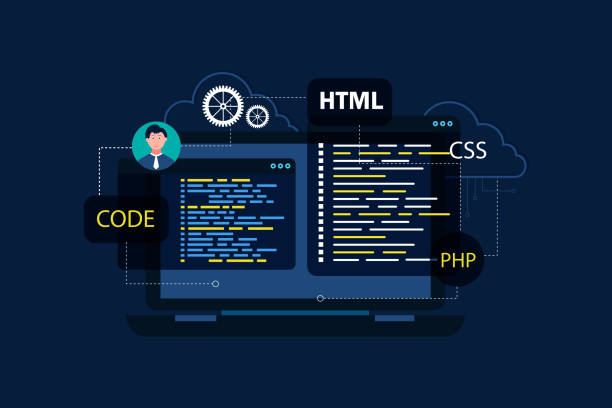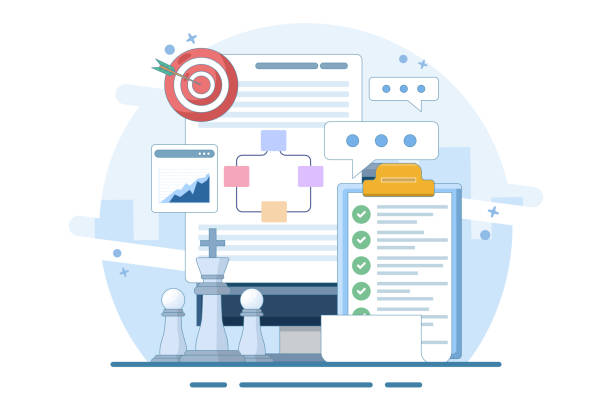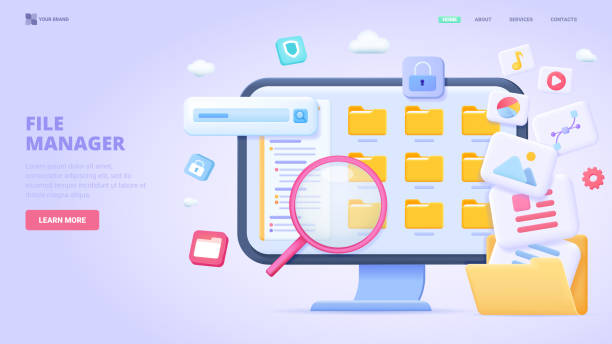Introduction to Secure Website Design and Its Importance in the Digital Age

In today’s world, where all businesses and communications are shifting towards virtual spaces, the topic of #secure_website_design is no longer an option, but an undeniable necessity.
Protecting user information, sensitive data, and preventing cyberattacks are among the most significant challenges faced by web developers and business owners.
An insecure website can lead to loss of credibility, financial damages, and even legal prosecution.
Therefore, a deep understanding of the principles of website security provisioning is vital for anyone active in this field.
This chapter, presented in an #explanatory and #informative manner, outlines the general concepts and high importance of a security approach in the initial stages of web development.
Cybersecurity is not just a technical aspect, but an organizational culture that must be institutionalized top-down across all levels of a website project.
Adhering to the principles of secure website design not only protects your business from threats but also builds user trust and provides a better user experience for them.
Neglecting this issue can have irreparable consequences for organizations.
From unauthorized access to users’ personal information to complete system shutdowns, all can be the result of insufficient attention to #website_protection.
Losing potential customers due to an unprofessional website? Rasaweb is your answer! With our specialized corporate website design services:
✅ Elevate your business’s credibility and standing
✅ Experience attracting more targeted customers
⚡ Act now to get a free consultation!
Identifying Common Threats and Website Vulnerabilities

To engage in secure website design, we must first become familiar with the types of threats that websites face.
This chapter, presented in an #educational and #specialized manner, introduces some of the most common #vulnerabilities and #cyberattacks.
Attacks such as SQL Injection, XSS (Cross-Site Scripting), CSRF (Cross-Site Request Forgery), and DoS/DDoS attacks are among those that constantly threaten websites.
Each of these attacks has its own methods for exploiting website security weaknesses and can cause irreparable damage.
For instance, in SQL Injection attacks, the attacker injects malicious SQL code into website inputs, potentially gaining access to or modifying the database.
In XSS, the attacker injects malicious script codes into web pages, which are then executed by other users’ browsers and can lead to the theft of cookies or session information.
Understanding these threats is the first step towards ensuring website security and planning to counter them.
Without a deep understanding of these weaknesses, any attempt at secure website design will be incomplete and ineffective.
Secure Coding Principles and Best Practices

#Secure_website_design begins at the foundational level of coding.
This chapter, presented as #guidance and #specialized content, examines the principles and best practices of #secure_coding that every developer must adhere to.
From rigorous Input Validation to the use of hash functions for password encryption and prevention of malicious code injection, all are considered core pillars of a secure website.
For example, all user inputs must be carefully checked and sanitized to prevent attacks like SQL Injection and XSS.
The use of Prepared Statements in databases significantly helps counter SQL Injection.
Furthermore, employing strong encryption and secure protocols like HTTPS is vital for transmitting sensitive information.
Choosing reputable and up-to-date frameworks and libraries with built-in security mechanisms can facilitate the process of website hardening.
| Security Feature | Secure Practice (Recommended) | Insecure Practice (Avoid) |
|---|---|---|
| Input Validation | Strict server-side validation for all inputs | Client-side validation only or no validation |
| Password Management | Use of strong hash functions (e.g., bcrypt) with Salt | Storing passwords in plain text or weak hashes (MD5) |
| Database Access | Use of Prepared Statements or ORM | Building queries with direct string concatenation of inputs |
| Error Handling | Displaying generic error messages and logging details | Displaying error details and sensitive information to the user |
| Software Updates | Regular updates of all components (CMS, plugins, frameworks) | No updates or delay in installing security patches |
The Importance of HTTPS Protocol and SSL/TLS Certificates

One of the most fundamental steps towards secure website design is the implementation of the HTTPS protocol.
This chapter, presented in an #explanatory and #educational manner, discusses the importance of HTTPS and the role of #SSL and #TLS certificates in #communication_security.
HTTPS (Hypertext Transfer Protocol Secure) is a secure version of the HTTP protocol that uses encryption to protect data during transmission between the user’s browser and the website server.
This encryption is provided by SSL/TLS certificates, which verify the website’s identity and ensure that data cannot be eavesdropped on or tampered with by a third party.
Without HTTPS, information such as usernames, passwords, credit card details, and other sensitive data are transmitted as plain text over the network and can be easily intercepted by attackers.
Installing SSL not only enhances security but also positively impacts website SEO and is considered an important ranking factor by search engines like Google.
This simple yet vital action builds user trust and assures them that their information is safe.
Every website aiming for complete security must prioritize the use of HTTPS.
Does your current e-commerce site design lead to losing customers and sales?
Rasaweb is your solution with modern and user-friendly e-commerce website designs!
✅ Significant increase in conversion rates and sales
✅ Building strong branding and earning customer trust
⚡ Get a free e-commerce website design consultation from Rasaweb!
Database Security and Preventing Injection Attacks

The heart of any website is its #database, and protecting it is of paramount importance for secure website design.
This chapter, presented as #specialized and #guidance content, focuses on database security and methods to prevent #injection attacks, especially SQL Injection.
SQL Injection is one of the most dangerous and common web attacks, allowing an attacker to inject malicious SQL queries into a website to access or modify sensitive information.
Key solutions include using Prepared Statements (or Parameterized Queries) which ensure the separation of code and data.
Also, applying the Principle of Least Privilege for database users, meaning that each user or service only has access to the minimum information and operations required for their tasks, is crucial.
The use of ORMs (Object-Relational Mappings) can also help enhance security, as they automatically prevent SQL injection.
Encrypting sensitive data in the database, regularly updating the Database Management System (DBMS) and using Database Firewalls are other effective measures for securing the database and, consequently, secure website design.
User Authentication and Access Management

In any web system, #authentication_management and #user_access_control are the cornerstones of secure website design.
This chapter, presented in an #educational and #explanatory manner, addresses the importance of implementing strong mechanisms for identifying user identities and managing their access levels.
Using strong passwords, implementing two-factor authentication (2FA), limiting unsuccessful login attempts (Brute-Force Protection), and utilizing Secure Cookies are among the measures that must be taken in this area.
Passwords must be hashed and salted and should never be stored in plain text.
Furthermore, after each successful authentication, a secure and unique Session ID must be generated, which regularly expires and is resistant to Session Hijacking attacks.
Precise management of access levels (Role-Based Access Control – RBAC) ensures that each user only has access to the resources and functionalities essential for their tasks.
These principles directly impact #user_security and #data_protection and are an integral part of a #secure_website.
Neglecting any of these can open the door to unauthorized access and internal attacks, jeopardizing the overall website security.
Security Auditing and Periodic Penetration Testing

After secure website design and implementation of initial principles, the #security process does not end.
This chapter, presented in an #analytical and #guidance manner, addresses the importance of #security_auditing and periodic #penetration_testing.
Penetration testing is the simulation of a real cyberattack on a website, performed by security experts with the aim of discovering vulnerabilities before they are discovered by actual attackers.
This process involves various stages including information gathering, vulnerability scanning, exploitation, and reporting.
Regular execution of these tests, whether internally or by external teams (Red Team), helps identify hidden weaknesses in code, server configuration, and even business logic.
Additionally, automated security scanners and manual code reviews are important complementary tools in this regard.
The results from these audits must be carefully analyzed, and necessary corrective actions to address vulnerabilities should be taken as soon as possible.
This proactive and defensive approach is an indispensable part of a comprehensive strategy for #website_protection and maintaining its security resilience.
| Audit/Test Type | Description | Main Goal |
|---|---|---|
| Black Box Penetration Test | The tester has no internal system information and acts like an external attacker. | Simulating a real attacker’s attack without prior knowledge |
| White Box Penetration Test | The tester has full access to system information (source code, architecture, configuration). | Discovering the most precise vulnerabilities in code and logic |
| Gray Box Penetration Test | The tester has limited system information (e.g., access to a normal user account). | Simulating an internal user’s attack or an attacker with partial access |
| Code Audit | Manual or automated review of source code to find vulnerabilities and security breaches. | Finding hidden vulnerabilities in application logic and coding |
| Vulnerability Scan | Using automated tools to identify known vulnerabilities. | Quick discovery of common vulnerabilities and misconfigurations |
Backup Strategies and Disaster Recovery

Even with the strongest security measures in secure website design, the probability of cyber or physical incidents never reaches zero.
This chapter, presented as #guidance and #specialized content, addresses the importance of #regular_backups and developing a #disaster_recovery_plan.
Regular data backup and storing them in a secure, separate location (off-site) is the first and most crucial step for rapid website recovery after an incident.
These incidents can include ransomware attacks, server hardware failures, natural disasters, or even human error.
A disaster recovery plan should include precise steps to restore the system to normal operational status as quickly as possible.
This plan should cover: identifying critical data and systems, backup scheduling, storage methods (such as cloud or physical disks), individual responsibilities, and regular recovery testing procedures.
Crisis preparedness helps organizations minimize damages and prevent long service interruptions during an incident.
Recovery Time Objective (RTO) and Recovery Point Objective (RPO) are also important concepts in recovery planning.
Did you know that 94% of users’ first impression of a business is related to its website design? With professional corporate website design by **Rasaweb**, turn this first impression into an opportunity for growth.
✅ Attract more customers and increase sales
✅ Build credibility and trust in the eyes of the audience⚡ Get a free website design consultation!
The Role of Education and Awareness for Users and Development Team

In the discussion of #web_security and secure website design, no firewall is stronger than an aware user.
This chapter, presented in an #engaging and #thought-provoking manner, examines the vital role of the #human_element in the #security_chain.
Many successful cyberattacks occur not due to technical weaknesses, but because users are tricked through social engineering.
Therefore, continuous education for users and all members of the development team, from managers to designers and coders, regarding the latest threats and best security practices, is essential.
Holding workshops, sending security newsletters, and conducting phishing simulation tests can significantly increase awareness levels.
Can we really expect users to always be vigilant? This is where it becomes thought-provoking: how can awareness be turned into a habit?
Establishing a strong security culture within the organization, where every individual understands their responsibility for security, is of paramount importance.
This culture significantly helps in strengthening overall website security and will prevent many attacks.
The Future of Secure Website Design and Emerging Challenges

The world of #cybersecurity is constantly evolving, and with the emergence of new technologies, new security challenges also arise.
This chapter, presented in an #analytical and #informative manner, predicts the #future_of_secure_website_design and examines future trends in this field.
With the expansion of Artificial Intelligence (AI), Internet of Things (IoT), and Blockchain, websites and web applications are becoming more complex, and consequently, the need for more advanced security solutions increases.
AI-based security can play an effective role in identifying attack patterns and preventing them.
Additionally, focusing on Zero Trust Architecture, which trusts no user or device without continuous verification, is an approach that will gain more attention in the future.
New challenges such as Quantum Attacks on current cryptographic systems highlight the necessity for research and development in post-quantum cryptography.
For sustainability in this dynamic environment, secure website design must be a continuous and adaptive process that constantly updates itself with new threats.
Awareness of these challenges and readiness to confront them is the key to success in maintaining security in the coming decades.
Frequently Asked Questions
| Question | Answer |
|---|---|
| What is secure website design? | Secure website design is a process where websites are built with security principles in mind to be resilient against cyberattacks and protect user and business information. |
| Why is secure website design of high importance? | To prevent unauthorized data access, sensitive information leaks, malware attacks, loss of user trust, damage to business reputation, and legal consequences arising from data breaches. |
| What are the most common website vulnerabilities? | SQL Injection, Cross-Site Scripting (XSS), Cross-Site Request Forgery (CSRF), broken authentication and session management, and sensitive data exposure. |
| How can SQL Injection attacks be prevented? | Using Prepared Statements with parameterized queries, Input Validation, and restricting database access. |
| What are the methods to counter XSS (Cross-Site Scripting) attacks? | User Input Validation, Output Encoding before displaying in HTML, and using Content Security Policy (CSP). |
| What is the role of HTTPS in website security? | HTTPS encrypts communication between the user’s browser and the website server using an SSL/TLS certificate, preventing eavesdropping, tampering, or forgery of data. |
| What are the best practices for managing user passwords? | Enforcing strong passwords (a combination of letters, numbers, and symbols), hashing passwords instead of direct storage (with strong algorithms like bcrypt), and enabling two-factor authentication (2FA). |
| What is the importance of user Input Validation? | Input validation prevents malicious or unexpected data from entering the system, which can lead to vulnerabilities like SQL Injection or XSS. |
| What impact do security reviews and regular audits have on site security? | These reviews help in early identification of vulnerabilities and security weaknesses, enabling their remediation before they can be exploited. |
| What is the application of Web Application Firewall (WAF) in secure website design? | A WAF acts as a protective layer between the user and the website, analyzing incoming traffic, and identifying and blocking common web attacks like SQL Injection and XSS. |
And other services by Rasaweb Advertising Agency in the field of advertising
Smart SEO: A fast and efficient solution for campaign management focusing on precise audience targeting.
Smart Marketing Automation: A fast and efficient solution for digital branding focusing on SEO-driven content strategy.
Smart Website Development: A professional solution for improving SEO ranking focusing on Google Ads management.
Smart Marketing Automation: Revolutionize customer acquisition with the help of key page optimization.
Smart Conversion Rate Optimization: Designed for businesses seeking to acquire customers through customized user experience.
And over hundreds of other services in internet advertising, advertising consultation, and organizational solutions
Internet Advertising | Advertising Strategy | Advertorial
Sources
Comprehensive Website Security GuideWebsite Security Checklist for DevelopersImportance of SSL and Security Certificates10 Steps for Secure Website Design
?Rasaweb Afarin Digital Marketing Agency is your partner on the path to achieving digital success. We transform your business with services such as modern UI website design, professional SEO, social media management, and content marketing.
📍 Tehran, Mirdamad Street, next to Central Bank, Southern Kazeroun Alley, Ramin Alley, No. 6



